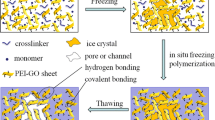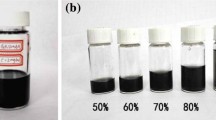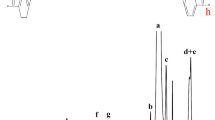Abstract
A catechol-containing organogel based on random copolymers of N-isopropylacrylamide (NIPAM) and dopamine methacrylate (NIDO5%) in dimethyl formamide (DMF) was supramolecularly crosslinked by NaBH4 in the presence of reduced graphene oxide (RGO). The focus of the investigations was on the influence of H2O and RGO in the system, which leads to a softening and stiffening, respectively. Whereas RGO tends to restack partially, this tendency was not found in the gels, suggesting a surface coverage of RGO with NIDO5% due to H-bonding and surface crosslinking attributed to the interactions of polar groups of polymer chains with carboxylic and carbonyl groups of RGO sheets proven by Fourier transform infrared spectroscopy (FTIR), transmission electron microscopy (TEM), and X-ray diffraction and spectroscopy (XRD). While RGO leads to the system becoming more brittle, its presence does not lead to an excessive loss of the self-healing characteristics, but it clearly stabilizes the gel when swollen with H2O, as can be seen from the significantly higher modulus and the retained self-healing behavior.













Similar content being viewed by others
References
Anderson BJ, Zukoski CF (2009) Rheology and microstructure of entangled polymer nanocomposite melts. Macromolecules 42(21):8370–8384
Bai H, Li C, Wang X, Shi G (2011) On the gelation of graphene oxide. J Phys Chem C 115(13):5545–5551
Brassinne J, Stevens AM, Van Ruymbeke E, Gohy J-F, Fustin C-A (2013) Hydrogels with dual relaxation and two-step gel–sol transition from heterotelechelic polymers. Macromolecules 46(22):9134–9143
Brubaker CE, Kissler H, Wang LJ, Kaufman DB, Messersmith PB (2010) Biological performance of mussel-inspired adhesive in extrahepatic islet transplantation. Biomaterials 31(3):420–7
Cassagnau P (2003) Payne effect and shear elasticity of silica-filled polymers in concentrated solutions and in molten state. Polymer 44(8):2455–2462
Castelletto V, Hamley IW, Ma Y, Bories-Azeau X, Armes SP, Lewis AL (2004) Microstructure and physical properties of a pH-responsive gel based on a novel biocompatible ABA-type triblock copolymer. Langmuir 20(10):4306–9
Chaterji S, Kwon IK, Park K (2007) Smart polymeric gels: redefining the limits of biomedical devices. Prog Polym Sci 32(8–9):1083–1122
Cheng C, Li S, Zhao J, Li X, Liu Z, Ma L, Zhang X, Sun S, Zhao C (2013a) Biomimetic assembly of polydopamine-layer on graphene: mechanisms, versatile 2D and 3D architectures and pollutant disposal. Chem Eng J 228:468–481
Cheng C, Nie SQ, Li S, Peng H, Yang H, Ma L, Sun SD, Zhao CS (2013b) Biopolymer functionalized reduced graphene oxide with enhanced biocompatibility via mussel inspired coatings/anchors. J Mater Chem B 1(3):265–275
Choong GYH, Focatiis DSA, Hassell DG (2013) Viscoelastic melt rheology and time–temperature superposition of polycarbonate–multi-walled carbon nanotube nanocomposites. Rheol Acta 52(8–9):801–814
Chunder A, Liu J, Zhai L (2010) Reduced graphene oxide/poly(3-hexylthiophene) supramolecular composites. Macromol Rapid Commun 31(4):380–4
Clément F, Johner A, Joanny JF, Semenov AN (2000) Stress relaxation in telechelic gels. 1. Sticker extraction. Macromolecules 33(16):6148–6158
Cong H-P, Wang P, Yu S-H (2013) Stretchable and self-healing graphene oxide–polymer composite hydrogels: a dual-network design. Chem Mater 25(16):3357–3362
Dang TT, Pham VH, Hur SH, Kim EJ, Kong BS, Chung JS (2012) Superior dispersion of highly reduced graphene oxide in N, N-dimethylformamide. J Colloid Interface Sci 376(1):91–96
Dong S, Luo Y, Yan X, Zheng B, Ding X, Yu Y, Ma Z, Zhao Q, Huang F (2011) A dual-responsive supramolecular polymer gel formed by crown ether based molecular recognition. Angew Chem Int Ed Engl 50(8):1905–9
Dong S, Zheng B, Xu D, Yan X, Zhang M, Huang F (2012) A crown ether appended super gelator with multiple stimulus responsiveness. Adv Mater 24(24):3191–5
D'souza F, Kadish KM (2012) Handbook of carbon nano materials, World Scientific
Faure E, Falentin-Daudré C, Jérôme C, Lyskawa J, Fournier D, Woisel P, Detrembleur C (2013) Catechols as versatile platforms in polymer chemistry. Prog Polym Sci 38(1):236–270
Fox J, Wie JJ, Greenland BW, Burattini S, Hayes W, Colquhoun HM, Mackay ME, Rowan SJ (2012) High-strength, healable, supramolecular polymer nanocomposites. J Am Chem Soc 134(11):5362–8
Friedrich T, Tieke B, Stadler FJ, Bailly C, Eckert T, Richtering W (2010) Thermoresponsive copolymer hydrogels on the basis of N-isopropylacrylamide and a non-ionic surfactant monomer: swelling behavior, transparency and rheological properties. Macromolecules 43(23):9964–9971
Friedrich T, Tieke B, Stadler FJ, Bailly C (2011a) Improvement of elasticity and strength of poly(N-isopropylacrylamide) hydrogels upon copolymerization with cationic surfmers. Soft Matter 7(14):6590–6597
Friedrich T, Tieke B, Stadler FJ, Bailly C (2011b) Copolymer hydrogels of acrylic acid and a nonionic surfmer: pH-induced switching of transparency and volume and improved mechanical stability. Langmuir 27(6):2997–3005
Ghavaminejad A, Hashmi S, Joh HI, Lee S, Vatankhah Varnoosfaderani M, Lee YS, Stadler FJ (2014) Network formation in graphene oxide composites with surface grafted poly-N-isopropyl amide chains in aqueous solution characterized by rheological experiments. Phys Chem Chem Phys 16:8675–8685
Guillet P, Mugemana C, Stadler FJ, Schubert US, Fustin C-A, Bailly C, Gohy J-F (2009) Connecting micelles by metallo-supramolecular interactions: towards stimuli responsive hierarchical materials. Soft Matter 5(18):3409
Hamley IW, Cheng G, Castelletto V (2011) A thermoresponsive hydrogel based on telechelic PEG end-capped with hydrophobic dipeptides. Macromol Biosci 11(8):1068–78
Hashmi S, Ghavaminejad A, Obiweluozor FO, Vatankhah-Varnoosfaderani M, Stadler FJ (2012) Supramolecular interaction controlled diffusion mechanism and improved mechanical behavior of hybrid hydrogel systems of zwitterions and CNT. Macromolecules 45(24):9804–9815
He L, Fullenkamp DE, Rivera JG, Messersmith PB (2011) pH responsive self-healing hydrogels formed by boronate-catechol complexation. Chem Commun (Camb) 47(26):7497–9
Hirata M, Gotou T, Horiuchi S, Fujiwara M, Ohba M (2004) Thin-film particles of graphite oxide 1. Carbon 42(14):2929–2937
Huang Y, Zeng M, Ren J, Wang J, Fan L, Xu Q (2012) Preparation and swelling properties of graphene oxide/poly(acrylic acid-co-acrylamide) super-absorbent hydrogel nanocomposites. Colloids Surf A Physicochem Eng Asp 401:97–106
Hyun K, Kim SH, Ahn KH, Lee SJ (2002) Large amplitude oscillatory shear as a way to classify the complex fluid. J Non-Newtonian Fluid Mech 107:51–65
Jeon EK, Seo E, Lee E, Lee W, Um MK, Kim BS (2013) Mussel-inspired green synthesis of silver nanoparticles on graphene oxide nanosheets for enhanced catalytic applications. Chem Commun (Camb) 49(33):3392–4
Kang SM, Park S, Kim D, Park SY, Ruoff RS, Lee H (2011) Simultaneous reduction and surface functionalization of graphene oxide by mussel-inspired chemistry. Adv Funct Mater 21(1):108–112
Khalatur PG, Khokhlov AR (1996) Computer simulation of solutions of telechelic polymers with associating end-groups. Macromol Theory Simul 5(5):877–899
Koike A, Nemoto N, Inoue T, Osaki K (1995) Dynamic light scattering and dynamic viscoelasticity of poly(vinyl alcohol) in aqueous borax solutions. 1. Concentration effect. Macromolecules 28(7):2339–2344
Ku SH, Lee M, Park CB (2013) Carbon-based nanomaterials for tissue engineering. Adv Healthc Mater 2(2):244–260
Kujawa P, Watanabe H, Tanaka F, Winnik FM (2005) Amphiphilic telechelic poly(N-isopropylacrylamide) in water: from micelles to gels. Eur Phys J E Soft Matter 17(2):129–37
Kumar R, Raghavan SR (2010) Thermothickening in solutions of telechelic associating polymers and cyclodextrins. Langmuir 26(1):56–62
Kundu A, Layek RK, Kuila A, Nandi AK (2012) Highly fluorescent graphene oxide-poly(vinyl alcohol) hybrid: an effective material for specific Au3+ ion sensors. ACS Appl Mater Interfaces 4(10):5576–5582
Kurth DG (2008) Metallo-supramolecular modules as a paradigm for materials science. Sci Technol Adv Mater 9(1):014103
Lee JH, Gustin JP, Chen T, Payne GF, Raghavan SR (2005) Vesicle--biopolymer gels: networks of surfactant vesicles connected by associating biopolymers. Langmuir 21(1):26–33
Lee DY, Yoon S, Oh YJ, Park SY, In I (2011) Thermo-responsive assembly of chemically reduced graphene and poly(N-isopropylacrylamide). Macromol Chem Phys 212(4):336–341
Lehn J-M (1995) Supramolecular chemistry—concepts and perspectives. VCH, Weinheim
Lehn JM, Mascal M, Decian A, Fischer J (1992) Molecular ribbons from molecular recognition directed self-assembly of self-complementary molecular-components. J Chem Soc-Perkin Trans 2(4):461–467
Liao D, Dai S, Tam KC (2007) Rheological properties of a telechelic associative polymer in the presence of alpha- and methylated beta-cyclodextrins. J Phys Chem B 111(2):371–8
Lu CH, Zahedi P, Forman A, Allen C (2014) Multi-arm PEG/silica hydrogel for sustained ocular drug delivery. J Pharm Sci 103(1):216–226
Mandal S, Lee MV, Hill JP, Vinu A, Ariga K (2010) Recent developments in supramolecular approach for nanocomposites. J Nanosci Nanotechnol 10(1):21–33
Menyo MS, Hawker CJ, Waite JH (2013) Versatile tuning of supramolecular hydrogels through metal complexation of oxidation-resistant catechol-inspired ligands. Soft Matter 9(43):10314–10323
Miller SG, Bauer JL, Maryanski MJ, Heimann PJ, Barlow JP, Gosau J-M, Allred RE (2010) Characterization of epoxy functionalized graphite nanoparticles and the physical properties of epoxy matrix nanocomposites. Compos Sci Technol 70(7):1120–1125
Mingos DMP (2004) Supramolecular assembly via hydrogen bonds. Springer, Berlin
Münstedt H, Katsikis N, Kaschta J (2008) Rheological properties of poly(methyl methacrylate)/nanoclay composites as investigated by creep recovery in shear. Macromolecules 41(24):9777–9783
Olsen BD, Johnson JA (2013) Reply to stadler: combining network disassembly spectrometry with rheology/spectroscopy. PNAS 110(22):E1973
Ott C, Ulbricht C, Hoogenboom R, Schubert US (2012) Metallo-supramolecular materials based on amine-grafting onto polypentafluorostyrene. Macromol Rapid Commun 33(6–7):556–61
Palser AHR (1999) Interlayer interactions in graphite and carbon nanotubes. Phys Chem Chem Phys 1(18):4459–4464
Park JK, Kim KS, Yeom J, Jung HS, Hahn SK (2012) Facile surface modification and application of temperature responsive poly(N-isopropylacrylamide-co-dopamine methacrylamide). Macromol Chem Phys 213(20):2130–2135
Phadke A, Zhang C, Arman B, Hsu CC, Mashelkar RA, Lele AK, Tauber MJ, Arya G, Varghese S (2012) Rapid self-healing hydrogels. Proc Natl Acad Sci U S A 109(12):4383–4388
Sahoo NG, Jung YC, Yoo HJ, Cho JW (2006) Effect of functionalized carbon nanotubes on molecular interaction and properties of polyurethane composites. Macromol Chem Phys 207(19):1773–1780
Sangeetha NM, Maitra U (2005) Supramolecular gels: functions and uses. Chem Soc Rev 34(10):821–36
Schmidt M, Münstedt H (2002a) On the elastic properties of model suspensions as investigated by creep recovery measurement in shear. Rheol Acta 41(3):205–210
Schmidt M, Münstedt H (2002b) Reological behaviour of concentrated monodisperse suspensions as a function of preshear conditions and temperature: an experimental study. Rheol Acta 41(3):193–204
Shen J, Yan B, Li T, Long Y, Li N, Ye M (2012) Study on graphene-oxide-based polyacrylamide composite hydrogels. Compos A: Appl Sci Manuf 43(9):1476–1481
Sijbesma RP, Kentgens APM, Lutz ETG, Van Der Maas JH, Nolte RJM (1993) Binding features of molecular clips derived from diphenylglycoluril. J Am Chem Soc 115(20):8999–9005
Sim HG, Ahn KH, Lee SJ (2003) Large amplitude oscillatory shear behavior of complex fluids investigated by a network model: a guideline for classification. J Non-Newtonian Fluid Mech 112(2–3):237–250
South AB, Lyon LA (2010) Autonomic self-healing of hydrogel thin films. Angew Chem Int Ed Engl 49(4):767–71
Stadler FJ (2013) Quantifying primary loops in polymer gels by linear viscoelasticity. Proc Natl Acad Sci U S A 110(22):E1972
Stadler FJ, Friedrich T, Kraus K, Tieke B, Bailly C (2013) Elongational rheology of NIPAM-based hydrogels. Rheol Acta 52(5):413–423
Stankovich S, Dikin DA, Dommett GH, Kohlhaas KM, Zimney EJ, Stach EA, Piner RD, Nguyen ST, Ruoff RS (2006) Graphene-based composite materials. Nature 442(7100):282–6
Sun S, Wu P (2011) A one-step strategy for thermal- and pH-responsive graphene oxide interpenetrating polymer hydrogel networks. J Mater Chem 21(12):4095
Suzuki S, Uneyama T, Inoue T, Watanabe H (2012) Nonlinear rheology of telechelic associative polymer networks: shear thickening and thinning behavior of hydrophobically modified ethoxylated urethane (HEUR) in aqueous solution. Macromolecules 45(2):888–898
Tanaka F (2000) Thermoreversible gelation strongly coupled to polymer conformational transition. Macromolecules 33(11):4249–4263
Tanaka F, Koga T, Kaneda I, Winnik FM (2011) Hydration, phase separation and nonlinear rheology of temperature-sensitive water-soluble polymers. J Phys Condens Matter 23(28):284105
Tripathi A, Tam KC, Mckinley GH (2006) Rheology and dynamics of associative polymers in shear and extension: theory and experiments. Macromolecules 39(5):1981–1999
Tsitsilianis C, Iliopoulos I, Ducouret G (2000) An associative polyelectrolyte End-capped with short polystyrene chains. Synthesis and rheological behavior. Macromolecules 33(8):2936–2943
Tung VC, Kim J, Cote LJ, Huang J (2011) Sticky interconnect for solution-processed tandem solar cells. J Am Chem Soc 133(24):9262–5
Vatankhah-Varnoosfaderani M, Ghavaminejad A, Hashmi S, Stadler FJ (2013) Mussel-inspired pH-triggered reversible foamed multi-responsive gel—the surprising effect of water. Chem Commun (Camb) 49(41):4685–7
Vatankhah-Varnoosfaderani M, Hashmi S, Ghavaminejad A, Stadler FJ (2014b) Rapid self-healing and triple stimuli responsiveness of a supramolecular polymer gel based on boron–catechol interactions in a novel water-soluble mussel-inspired copolymer. Polym Chem 5(2):512–523
Watanabe H, Sato T, Osaki K, Aoki Y, Li L, Kakiuchi M, Yao ML (1998) Rheological images of poly(vinyl chloride) gels. 4. Nonlinear behavior in a critical gel state. Macromolecules 31(13):4198–4204
Whiteside NJ, Wallace GG, In Het Panhuis M (2013) Preparation and characterisation of graphene composite hydrogels. Synth Met 168:36–42
Yan X, Xu D, Chi X, Chen J, Dong S, Ding X, Yu Y, Huang F (2012) A multiresponsive, shape-persistent, and elastic supramolecular polymer network gel constructed by orthogonal self-assembly. Adv Mater 24(3):362–9
Zerkowski JA, Seto CT, Whitesides GM (1992) Solid-state structures of rosette and crinkled tape motifs derived from the cyanuric acid melamine lattice. J Am Chem Soc 114(13):5473–5475
Zhang N, Li R, Zhang L, Chen H, Wang W, Liu Y, Wu T, Wang X, Wang W, Li Y, Zhao Y, Gao J (2011) Actuator materials based on graphene oxide/polyacrylamide composite hydrogels prepared by in situ polymerization. Soft Matter 7(16):7231
Zhang M, Xu D, Yan X, Chen J, Dong S, Zheng B, Huang F (2012) Self-healing supramolecular gels formed by crown ether based host-guest interactions. Angew Chem Int Ed Engl 51(28):7011–5
Zhou H, Woo J, Cok AM, Wang M, Olsen BD, Johnson JA (2012) Counting primary loops in polymer gels. PNAS 109(47):19119–24
Acknowledgments
The authors acknowledge financial aid from the National Research Foundation of Korea (110100713, 2015–020449), the National Science Foundation of China (21574086), Nanshan District Key Lab for Biopolymers and Safety Evaluation (No. KC2014ZDZJ0001A), and Shenzhen City High Level Talent Program and Shenzhen Sci & Tech research grant (ZDSYS201507141105130, JCYJ20140509172719311). The authors would also like to thank the staff of the CBNU central lab.
Author information
Authors and Affiliations
Corresponding author
Additional information
Amin GhavamiNejad and Saud Hashmi contributed equally to this work.
Electronic supplementary material
Below is the link to the electronic supplementary material.
ESM 1
(DOCX 219 kb)
(AVI 21078 kb)
(AVI 25045 kb)
Rights and permissions
About this article
Cite this article
GhavamiNejad, A., Hashmi, S., Vatankhah-Varnoosfaderani, M. et al. Effect of H2O and reduced graphene oxide on the structure and rheology of self-healing, stimuli responsive catecholic gels. Rheol Acta 55, 163–176 (2016). https://doi.org/10.1007/s00397-015-0906-3
Received:
Revised:
Accepted:
Published:
Issue Date:
DOI: https://doi.org/10.1007/s00397-015-0906-3




